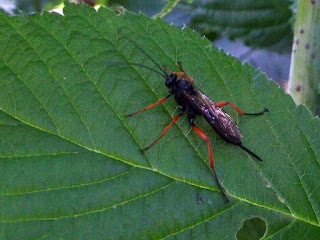Parasitic Wasp
Black Slip Wasp (Pimpla rufipes) female.
This is one wasp we were very happy to see on our plot recently. The Black Slip Wasp is a large, parasitoid wasp common to Europe and North Africa. It has a body length of 10-24 mm and is black with orange-red on its legs. The reason we like it? It preys on the Cabbage White Butterfly!
As we garden organically, this a really useful natural predator. The female has a long ovipositor as can be seen in the photo (click to enlarge), and searches for butterfly pupae, into which she will inject one of her eggs.
The egg hatches inside the butterfly pupa and the wasp larva feeds on the blood and living tissue of its host, avoiding vital organs in the early stages in order to prolong its food source. Eventually, it will eat the whole of the pupa from inside out, and then pupate itself. Two weeks later, the young Black Slip Wasp hatches and is ready to leave the host, which by now is just a shell.
The ovipositor can be mistaken for a sting, but the wasp is not capable of stinging a human. The male wasp can be distinguished easily as it doesn't possess an ovipositor. Instead it searches for emerging females with which to mate and dies soon after.
Unfortunately, if you are using pesticides to control the caterpillar population, then you will also have killed one of the best weapons against them. You will not be able to marvel at this amazing yet brutal product of nature!
As we garden organically, this a really useful natural predator. The female has a long ovipositor as can be seen in the photo (click to enlarge), and searches for butterfly pupae, into which she will inject one of her eggs.
The egg hatches inside the butterfly pupa and the wasp larva feeds on the blood and living tissue of its host, avoiding vital organs in the early stages in order to prolong its food source. Eventually, it will eat the whole of the pupa from inside out, and then pupate itself. Two weeks later, the young Black Slip Wasp hatches and is ready to leave the host, which by now is just a shell.
The ovipositor can be mistaken for a sting, but the wasp is not capable of stinging a human. The male wasp can be distinguished easily as it doesn't possess an ovipositor. Instead it searches for emerging females with which to mate and dies soon after.
Unfortunately, if you are using pesticides to control the caterpillar population, then you will also have killed one of the best weapons against them. You will not be able to marvel at this amazing yet brutal product of nature!
Submitted by Tigger

Comments
Post a Comment